If we could ever train animals to follow blocking and precise stage directions night after night, they might actually take over theater as we know it. Because nothing captures an audience’s attention the way a live animal does. Directors place animals onstage at their own peril, in fact: Once a dog or cat enters (or even a well-designed puppet of same), an audience pretty much forgets everything else you’ve placed front of it.
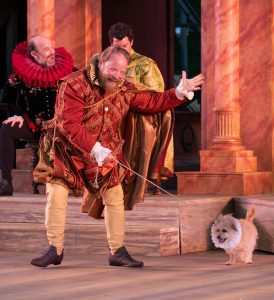
‘Buster’ Rogge starred in Heart of America Shakespeare Festival’s ‘Shakespeare in Love’ / Photo HASF
Yet playwrights, opera composers, and choreographers continue to include animals in their works, leaving directors with the task of making it “work.” And while Broadway and Hollywood can hire expensive trainers, in Kansas City it’s an issue that directors struggle with constantly.
“You really do not have control of a live animal,” said Cynthia Levin, producing artist director of the Unicorn Theatre, who has had extensive experience with dogs, cats, birds, and worse onstage. “Luckily, labs and golden retrievers are the best that I’ve had to train for those situations.”
Local audiences are no strangers to animals onstage, and will be familiar with the level of distraction they cause. I personally have watched a half-dozen productions of the Kansas City Ballet’s Giselle, which like most versions contains a scene with a Great Dane or a borzoi, and I couldn’t describe to you a single thing the dancers were doing during those sequences. For those few moments, at least, all you look at is the dog.
Both the theatrical and the operatic adaptations of Steinbeck’s Of Mice and Men contain a critical “role” for a canine, though he’s usually on a leash and simply sits still for long periods. At the Rep’s most recent production, however, actor Manon Halliburton’s 11-year-old Labrador, Molly, stole every scene she was in.
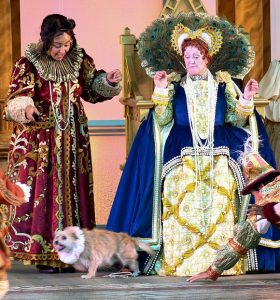
Jan Rogge (right) appeared live with her ‘family member,’ Buster / Photo HASF
The Heart of American Shakespeare Festival is not above using an irresistible pet occasionally. Actor Jan Rogge’s Buster was featured in last season’s Shakespeare in Love (and it was not even his stage debut!). “The Queen loves a dog,” said Sidonie, the Festival’s director, of the role in which Jan herself appeared. “And in this case, the Queen was our canine actor’s ‘doggy Mom.’ ”
Cynthia has used several of her own dogs onstage, most notably the late Golda, a golden retriever who also appeared at the Coterie and the Kansas City Repertory Theatre. “There are dogs … that’ll do it,” she said, “and then there are certain dogs that are stubborn little things.” Among the latter is Cynthia’s current darling, Zia, who would follow stage directions “only if you make a line of cookies on the floor that she could follow.”
Golda, on the other hand, was born for the stage. “When Golda was at the Rep, she got a paycheck,” Cynthia said with a laugh. “I just thought that was the coolest thing ever.” When Cynthia asked the Rep to include Golda’s head shot on the lobby wall with the other actors’ photos, they complied.
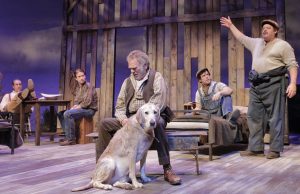
‘Molly’ Halliburton starred in Kansas City Repertory Theatre’s ‘Of Mice and Men’ / Photo by Cory Weaver
As for felines, Cynthia said: Please, no. “We’ve done a couple of plays with cats, and man! … I would love to talk to every single playwright who wants a cat onstage, because cats do not want to do what you tell them.”
The Unicorn’s production of The Lieutenant of Inishmore featured a live feline, “and I would say our cat did what it needed to do 75 percent of the time,” Cynthia said. “That’s as good as it gets with a wild animal.”
The Unicorn has used even more exotic animals, most notably a ball python for the fundamentalist snake handler of Talking With. “I tell you, when that snake came out of the cage, the people on the front row were freaking out,” Cynthia said. Thus not all animal distractions are of the “aww, cute!” variety, she said. “It depends on the animal: from people saying ‘Oh, look at the little dog!’ as opposed to ‘Augh! look at that snake!’ ”
IS IT LIVE, OR IS IT MESNER?
Perhaps it’s no wonder, then, that producers have taken to puppetry, which offers a viable option to the vagaries of living creatures. Fortunately, one of the nation’s most prominent puppet ensembles is based right here in Kansas City: Mesner Puppet Theatre has had its share of creations on local stages, in addition to the animals it creates for its own mainstage productions. In 2018, Mike Horner and the company created one of the most remarkable puppets we’ve seen in Kansas City: a representation of Diego, the actual service dog that actor Logan Black used to sniff out bombs in Iraq while serving in the U.S. Army’s Specialized Search Dog unit.
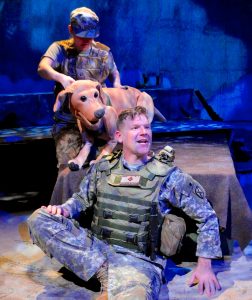
Logan Black told his own war stories in the one-man play Bond, with the help of Mesner Puppet Theatre’s ‘Diego’ / Photo by Cynthia Levin
Logan’s one-man play Bond, one of the hits of the Unicorn Theatre’s 2018-2019 season, chronicled the vital relationship of soldier and service dog: But the real Diego had died since Logan’s Iraq tours, and in any event the idea of a live canine “acting” onstage for 90 minutes seemed implausible.
In such cases, Mike said, the goal is not to create a puppet that looks eerily, distractingly realistic, but rather one that “gives enough information that the audience can fill in the blanks. We rely on that in puppetry all the time.”
Diego was a modification of the Japanese bunraku tradition, in which the puppeteer appears onstage but remains unobtrusive: If the drama is engaging enough, you quickly forget about the dark-clad additional figure onstage.
Mike has created puppets for other companies (a sea turtle for Spinning Tree Theatre’s Shipwrecked, for example, and various creatures for Shrek the Musical performed around the region), and he makes countless animals for his company’s own shows. Some of them talk: When Mike recounts fables, his puppets often take on a variety of human characteristics.
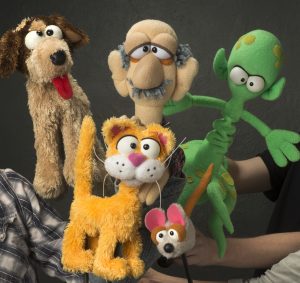
‘The Cat Came Back’ is an audience favorite at Mesner Puppet Theatre
“Kids understand that it’s not real, that this is a story they’re being told,” he said. “And they buy into the characters: That’s just good theater.”
Even in traditional theater, though, “puppet animals” drag an audience’s attention from the action, as several local companies have learned.
What many remember most from the Kansas City Ballet’s production of Septime Webre’s The Wizard of Oz, for example, was designer Nicholas Mahon’s Toto (not to mention the harrowing Flying Monkeys).
Puppets might be the wave of the future in theater, and local productions such as Bond have shown that they can be as effective as live animals. “It is absolutely true,” Cynthia said of cuddly Diego. “As soon as that dog puppet came onstage, that’s where everybody looked.”
To reach Paul Horsley, performing arts editor; send an email to paul@kcindependent.com or find him on Facebook (paul.horsley.501) or Twitter (@phorsleycritic).